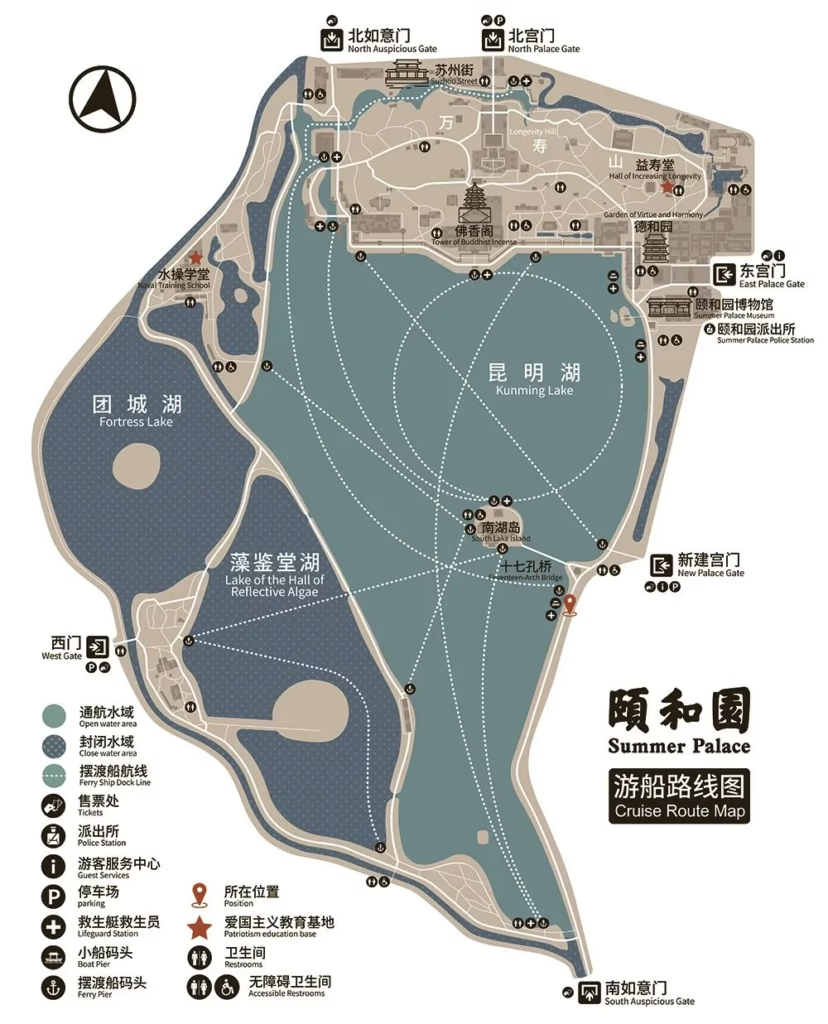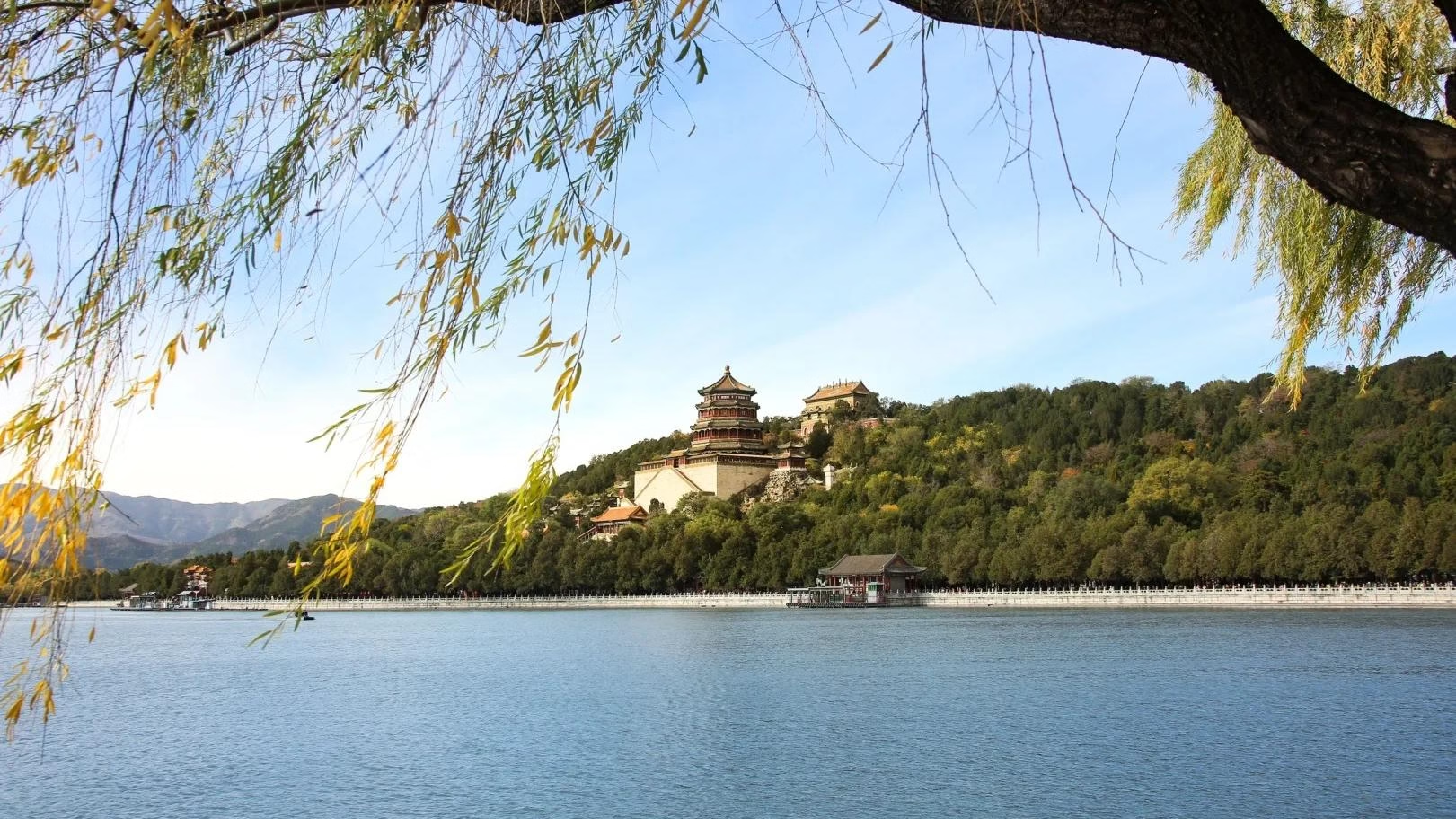The Summer Palace (颐和园) is one of China’s most famous and expansive royal gardens, often regarded as the most grand of the Four Great Gardens of China. It is divided into different areas, each accessible through one of its four main gates: the East Palace Gate (东宫门), the North Palace Gate (北宫门), the New Palace Gate (新建宫门), and the South Ruyi Gate (南如意门). Each gate has its unique charm and offers different experiences. The attractions near the East and North Palace Gates are the most concentrated, while those near the other gates are more dispersed. Here’s a breakdown of what to see at each entrance.

1. East Palace Gate (东宫门)
Best for: Political and Historical Sites
Estimated Time to Explore: 2 hours (though you may miss some spots)
How to Get there: Accessible by Subway Line 4 (Xiyuan Station) and several bus routes (331, 332, 346, 303, 584, Night Bus 8).
The East Palace Gate is the most popular entrance, especially for those interested in exploring the historical and political side of the Summer Palace. Key sites here include:
- Ren Shou Dian (仁寿殿): This hall was used by the court to handle state affairs.
- De He Yuan (德和园): A theater where Empress Dowager Cixi watched performances.
- Summer Palace Museum (颐和园博物馆): A museum showcasing the history of the palace.
- Zhi Chun Ting (知春亭): A pavilion offering panoramic views of the entire garden.
- Yu Lan Tang (玉澜堂): The residence of Emperor Guangxu, where Empress Dowager Cixi once confined him.
- Yi Yun Guan (宜芸馆): Formerly a library that housed imperial books.
- Long Corridor (长廊): Famous for its artistic paintings and intricate design.
- Fo Xiang Ge (佛香阁): The Buddha Fragrance Pavilion, where Empress Dowager Cixi once prayed.
- Xie Qu Yuan (谐趣园): A garden with Jiangnan-style features, showcasing traditional Chinese garden design.
This route gives a comprehensive view of the Summer Palace’s political and cultural heritage, making it ideal for history enthusiasts.
2. North Palace Gate (北宫门)
Best for: Residential and Scenic Locations
Estimated Time to Explore: 2-3 hours
How to Get there: Accessible by Subway Line 4 (Beigongmen Station) and several bus routes (303, 331, 332, 346, 384, 394, 563, 584, 594, 601, Night Bus 8, Sightseeing Bus Line 3).
The North Palace Gate focuses more on the residential and leisurely aspects of the Summer Palace, with a mix of traditional architecture and serene lakeside views. Notable spots near this entrance include:
- Fushi (福慈): A peaceful area featuring classical Chinese architecture.
- Suzhou Street (苏州街): A recreation of a Jiangnan commercial street. It’s particularly beautiful for photography in the winter months when it’s less crowded.
- Si Da Bu Zhou (四大部洲): A group of Tibetan-style buildings. These are modeled after the Four Great Regions in Chengde and are architecturally significant.
- Song Tang (松堂) & Yun Hui Si (云会寺): Traditional structures offering a glimpse of Qing dynasty life.
- Qi Wang Xuan (绮望轩遗址): The ruins of a pavilion with scenic views of Kunming Lake.
- Wan Shou Shan (万寿山): The “Longevity Mountain,” offering a beautiful backdrop for photos.
- Pai Yun Dian (排云殿): A set of Han and Tibetan architectural buildings originally constructed for Empress Dowager Cixi’s birthday celebrations.
This gate offers a blend of serene landscapes and historical sites, making it a great option for those interested in traditional gardens and leisurely activities.
3. New Palace Gate (新建宫门)
Best for: Scenic Views and Relaxation
How to Get there: Accessible by Bus routes 74, 374, 437.
Key Attractions:
- Kuo Ru Ting (廓如亭): A peaceful pavilion.
- Tong Niu (铜牛): The famous bronze ox, a symbol of power and prosperity.
- Kunlun Stone Stele (昆仑石碑): A historical marker in the area.
- Seventeen-Arch Bridge (十七孔桥): A popular photography spot.
- Hong Cai Pai Lou (虹彩牌楼): The iconic Rainbow Archway, a well-known symbol of the Summer Palace.
This gate is ideal for those who want to relax by the water and enjoy scenic photography.
4. South Ruyi Gate (南如意门)
Best for: Nature and Tranquility
How to Get there: Accessible by Bus routes 374, 74, 437, and offers parking facilities.
Key Attractions:
- Phoenix Dun (凤凰墩): A large stone mound.
- Xi Ti (西堤): A beautiful causeway lined with trees and ideal for a walk.
- Liu Qiao (柳桥): A charming willow bridge.
- Jing Ming Lou (景明楼): A classical pavilion with sweeping views.
- Yu Dai Qiao (玉带桥): The famous Jade Belt Bridge, a picturesque spot for photography.
This gate is less crowded and offers a peaceful, natural experience, making it perfect for nature lovers and those seeking tranquility.

